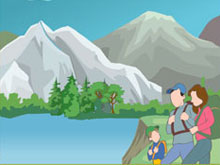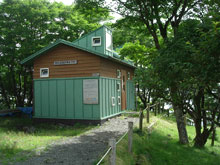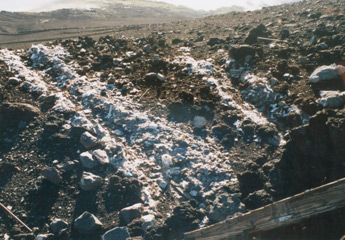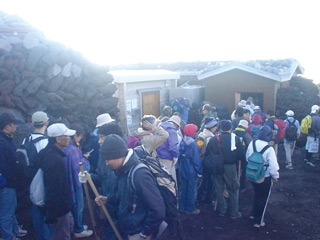Human waste treatment in natural areas: human waste treatment technology field
 Nature
in mountain districts, coastal areas and remote islands
Nature
in mountain districts, coastal areas and remote islands Installation
of a simplified water-circulating toilet
Installation
of a simplified water-circulating toiletHuman Waste Problem in Natural Areas
In mountain districts or similar areas where the power supply and water supply systems are generally poor, human waste used to be disposed of by digging a hole for storage and infiltration. In areas without even a basic toilet, faeces were inevitably excreted outdoors.Meanwhile, the recent mountaineering boom means an increasing number of visitors to mountain districts and there has been growing concern in regard to the adverse impacts of human waste on the water quality of public water areas as well as vegetation.
Against the background of such increasing concern, mountain lodge operators and local governments have begun efforts to improve the method of human waste disposal. At the same time, there has been the rapid development and commercialization of human waste treatment systems which do not discharge cleaning water or treated sewage.
To reduce the adverse impacts of human waste in natural areas with little infrastructure development, voluntary efforts, including the adoption of suitable technologies and systems, are hoped for.
 |
 |
Database for the Introduction of Human Waste Treatment Technologies to Natural Areas
<Reminder for Users>This database classifies cases where either verified technologies under the ETV Program or non-discharge type human waste treatment technologies (systems) installed by the MoE or local governments in natural parks from the seven viewpoints of (A) through (G) listed below.
As this database does not evaluate individual technologies, users must bear in mind that this database simply offers reference information for their selection of a suitable technology. (For the selection of a suitable technology, it is essential to examine the candidate technologies from multiple viewpoints, including the information provided by this database.)
<Viewpoints>- (A) General view
- Looking through the entire website
- (B) Power supply requirement
- Commercial power source / non-utility power generation facility / natural energy (sunlight, wind power and other / not required
- (C) Method to secure water supply
- Public water supply system / rainwater and melt water / well, etc // transported/not required
- (D) Method of transportation
- Automobile / helicopter / manual/other
- (E) Minimum temperature
- -5°C or higher / lower than -5°C
- (F) Area of introduction
- Mountain area / mountain foot area (accessible by vehicle) / beach / remote island / other
- (G) Treatment method
| Treatment Method | Characteristics | Technical Explanation |
|---|---|---|
| Biological treatment | Soil | Treatment using the adsorption and filtration functions of soil particles and/or soil microbes |
| Treatment using biofilms and soil microbes | ||
| Additive agent | Addition of an agent or enzyme as an adjurant in the biological treatment process | |
| Oyster shells | Treatment with a biological membrane while using oyster shells as the contact agent | |
| Membrane | Solid-liquid separation by a biological membrane after treatment with activated sludge | |
| Wood | Treatment by a biological membrane while spraying the wastewater over wood chips used as the contact agent | |
| Physical treatment | Drying / incineration | Drying and incineration of sewage for powderisation |
| Other than the above | - |
Other Human Waste Treatment Methods Used in Natural Areas
| Type of Technology | Characteristics / Important Points |
| Portable toilet | Human waste is packed to take back. Coordination with the local government is required for collection and disposal of the packed waste. |
| Cartridge system | Human waste is stored in a cartridge type tank for transportation by helicopter, etc. to a piedmont where it is emptied. |
| Johkasou | Inspection and management are required in accordance with Johkasou Act. A destination area for discharge of the treatment water must be available. |



















